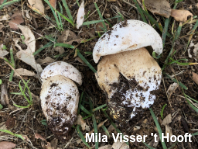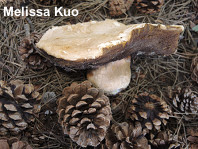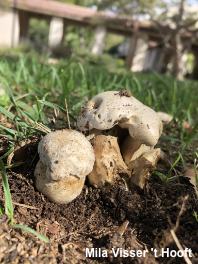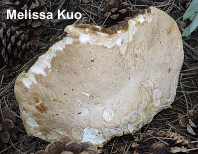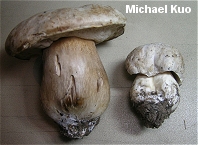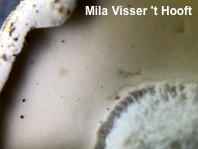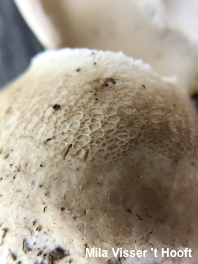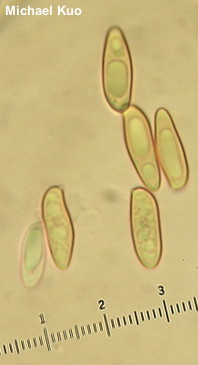| Major Groups > Boletes > Edulis Group > Boletus barrowsii |

|
Boletus barrowsii [ Basidiomycota > Boletales > Boletaceae > Boletus . . . ] by Michael Kuo This western species is an impressive, whitish member of the Boletus edulis group. It is found primarily under ponderosa pine in the Southwest, and under coast live oak on the West Coast. Like most other members of the species group it features a robust, finely reticulate stem and a non-bruising pore surface. The pores, when young, are "stuffed" in appearance, and white—and the flesh does not turn to blue when sliced. Boletus barrowsii also differs from other edulis-like species in not having a clearly defined cap skin (a "cuticle" in Mycologese). Thanks to Mila Visser 't Hooft for documenting, collecting, and preserving Boletus barrowsii for study; her collection is deposited in The Herbarium of Michael Kuo. Description: Ecology: Mycorrhizal with ponderosa pine and occasionally with spruces in the Southwest and in Colorado—and with coast live oak on the West Coast; growing alone, scattered, or gregariously; summer and fall (monsoon season) in the Southwest—or fall and winter on the West Coast; ranging as far north as British Columbia. The illustrated and described collections are from California and Colorado. Cap: 5–16 cm; convex, becoming broadly convex or almost flat; dry; dull; bald; whitish, becoming pale brownish with age. Pore Surface: Whitish and appearing "stuffed" when young; becoming yellow and eventually olive yellow; not bruising; 1–2 pores per mm at maturity; tubes to 2 cm deep. Stem: 5–15 cm long; 2–5 cm thick; club-shaped when young, but usually becoming more or less equal by maturity; solid; whitish; not bruising, but sometimes becoming brownish with age; finely reticulate over the upper portion or nearly overall. Flesh: White; not staining on exposure. Odor and Taste: Pleasant; not distinctive. Spore Print: Olive brown. Microscopic Features: Spores 12–17 x 4.5–6 µm; fusiform; smooth; ochraceous in KOH. Hymenial cystidia 30–40 x 10–15 µm; clavate to subclavate, or occasionally fusoid-ventricose; smooth; thin-walled; hyaline in KOH. Pileipellis not clearly differentiated from pileus context; upper layer of hyphae cutis-like, hyaline, elements 5–7.5 µm wide and smooth, exserted hyphal ends cylindric with rounded apices. REFERENCES: Thiers & Smith, 1976. (Thiers, 1976; Arora, 1986; States, 1990; Phillips, 1991/2005; Both, 1993; Bessette, Roody & Bessette, 2000; Arora, 2008; Trudell & Ammirati, 2009; Desjardin, Wood & Stevens, 2015; Cripps, Evenson & Kuo, 2016; Evenson, 2016; Siegel & Schwarz, 2016.) Herb. Kuo 08091505, 09182002. This site contains no information about the edibility or toxicity of mushrooms. |
© MushroomExpert.Com |
|
Cite this page as: Kuo, M. (2022, February). Boletus barrowsii. Retrieved from the MushroomExpert.Com Web site: http://www.mushroomexpert.com/boletus_barrowsii.html |
